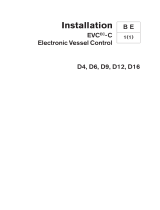
6 030626.03 Electronic engine remote control
It follows the table with the definition of LED and push buttons.
Push-button LED Description
Engine The left LED is for the port (left) engine, while the right LED is for the star-
board (right) engine. If the LED has a fixed light on (green), the correspond-
ing gearbox is in neutral position.
If a command station has not the command, a blinking (green) LED indi-
cates that the lever on the LED’s side is synchronised with the lever of the
station that at the moment has the Command.
Command If it is switched off, the Station has not the command.
If is switched on, the Station has the command.
Warm/Sync If it is blinking, the navigation system is in Warm-up mode; this means that
the engines can be accelerated without clutching-in the gear.
If the LED is fix lighted, the system is in Synchro mode.
Warm/Sync When both the levers of the Station that has the command are in neutral
position, if you press for 1,5 seconds the button Warm, it is activated the
function Warm-up.
Command If you press Command for 1,5 seconds the station takes the command, only
if one of these two conditions are respected:
- both the lever of the station are in neutral
- both the lever are synchronized with respect to the levers of the station
that at the moment has the command
All LEDs are lighted on The control system isn’t working correctly
3.4 Acquisition of the command
It is possible to acquire the command of the boat from any Station in the following cases:
• The boat isn’t moving
1. Position both the levers in neutral and press Command for 1,5 seconds.
2. LED “Command” is now lighted on while the warm/synch LED is blinking. You are in Warm-up mode: throttle com-
mand is enabled but clutch command is disabled.
3. To take the command you must press for 1,5 seconds the Warm/Sync bush-button, afterwards the station acquires
the command.
• In navigation
1. Synchronize the 2 levers of the Station which wants to acquire the command with respect to the Station which has
the command.
2. When LEDs “Engine” of the station which wants to acquire the command are blinking, these levers are synchronised
with the levers of the station which still has the command.
3. By pressing the pushbutton Command for 1,5 seconds, the new station takes the command.
Important: before taking the command, proof that all the passengers are safely on board.
3.5 Engine Warm-up
If both levers are in neutral, by pressing for 1,5 seconds the button Warm/Sync of the Station which has the command,
you enter in Warm-up mode. If you move the lever, it is only affected the accelerator but not the gear. In Warm-up mode
the LED Warm/Sync is blinking.
After positioning again both levers in neutral and pressing for 1,5 seconds the Warm/Sync, the system comes back to the
normal operation mode.






















